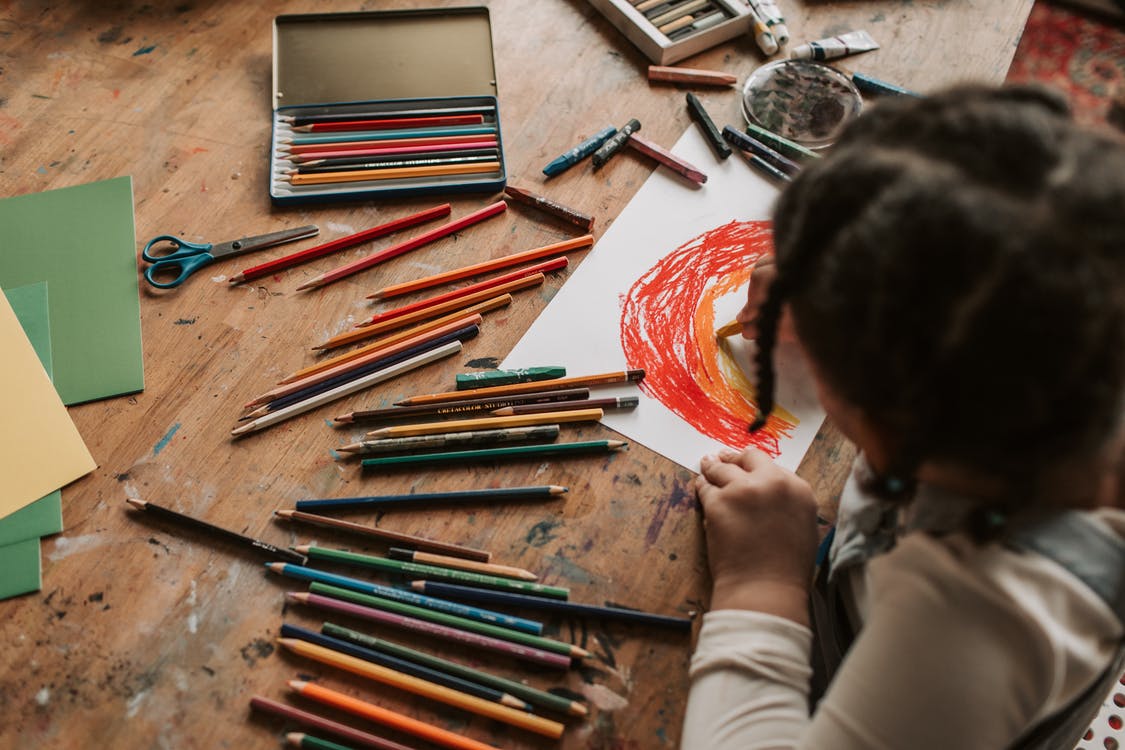With a growing apathy towards art education in academic institutions, it’s important to understand why art is important in school.
Art is any action or product designed with aesthetic and communicative intent. Art is intended to convey ideas, feelings, or a view of the world through the lens of the artist. It’s important for us to remember this, quite often when we think about art, particularly in schools, we just think about painting and drawing. In reality it covers performing arts, music and a whole host of other activities.
Creativity is an innate trait in all human beings, since the dawn of time we have sought out ways to express ourselves. For that reason, children naturally explore artistic activities from an early age. A child will learn to make marks with paint or pens or try to sing and dance before they can properly form a sentence. Artistic activities develop the sensory, motor, cognitive, and emotional centers of the brain. Ultimately, creative activities enable a child to “learn how to learn“.
Over time we see art education at a school level slowly taking more of a back seat to other types of learning, but is that the right thing to do? Should we accept it? What benefits are there in exploring arts in school? Let’s look try to answer those questions.
Benefits of art education
Art can deeply shape a child’s life. All schools, public or private, have arts education in their subjects and out-of-school activities. If taught properly, students can make important advancements in their personal, academic, and social lives.
Painting, theater, dance, drawing, and music, help children understand themselves and express their inner world more effectively. It gives them the tools needed to translate their innermost thoughts and feelings and communicate them with confidence. By exploring their own feelings they become more conscious of the inner thoughts and feelings of others. Therefore, the more we expose children to art, the more we see increased empathy, social skills, and awareness.
The act of creating forces students to solve problems independently. The small hurdles overcome in creating something from nothing help a child develop a sense of agency, confidence, and freedom. As a result, exercises housed in creative agility go towards supporting creative thinking, problem-solving, and independence.
In short, learning art in schools:
- Reinforces the quality of learning
- Increases a student’s enthusiasm and environmental awareness.
- Promotes flexibility of thought.
- Reinforces a student’s confidence and independence.
- Stimulates mental agility.
- Develops effective communication skills.
- Helps children perform better in social environments.
- Promotes a healthier environment in school among the students.
- Helps build better relationships with teaching staff.
In conclusion, arts training allows children to acquire skills and habits that work in harmony with the learning environment. That is to say, it fosters communication and problem-solving skills, and makes for more sensitive, empathetic, and creative students.
“The arts teach children that real problems often have more than one possible solution, that it is necessary to analyze tasks from different perspectives, that imagination is a powerful guide in the resolution processes, or that there are not always definite rules when they have to make decisions.”
Elliot Eisner
Arts education in schools
UNESCO and many other global groups, fight for more appreciation for arts training. Whereas, In contrast, schools seem to increasingly undervalue art. But why is that?
According to psychologist and researcher Howard Gardner in his book “Art Education and Human Development”:
The challenge in arts education is to modulate effectively among the values of the culture, the means available for arts education and assessment, and the particular developmental and individual profiles of the students who are to be educated”
Howard Gardner, J. Paul Getty museum (Los Angeles, Calif.). · 1990
The lack of art in the classroom is due to a general indifference to artistic pursuits as part of curricular development. This is because of a lack of good teacher training, the absence of a cultural policy, and the belief is that art is not a valid career path. With the help of international groups, the tide does seem to be turning on these antiquated ideas.
A boom in independent and online learning, the popularity and accessibility of art online, and the popularity of art and creativity in social media are forcing institutions to play a more active role in a child’s creative development. We wouldn’t accept a child’s mathematic or linguistic education to be handled by online media, neither should we accept it for arts education.
A qualified teacher can actively assure that the goals in the last section (autonomy, communication skills, the flexibility of thought, etc.) are being met. The objective of art in school isn’t necessarily to make a school play, create paintings for mom and dad’s refrigerator, or learn to sing a particular song. Those are just pleasant bi-products of a more important overall purpose.
So, why art is important in school?
Arts education allows students to acquire several basic social and emotional skills necessary for personal development; it prepares them for life both in and out of the classroom and helps facilitates learning.
To neglect creative pursuits in a young person’s education is to neglect a crucial part of their development. Just as we wouldn’t want their physical education to be wholly conducted out of school, we shouldn’t accept it for their artistic learning.
A school is efficient when it is committed to developing a student’s creativity and artistic expression. In short, art is and should be, at the heart of the entire educational system. The brain loves challenges and, therefore, needs artistic stimulation, that’s why art is important in school.
